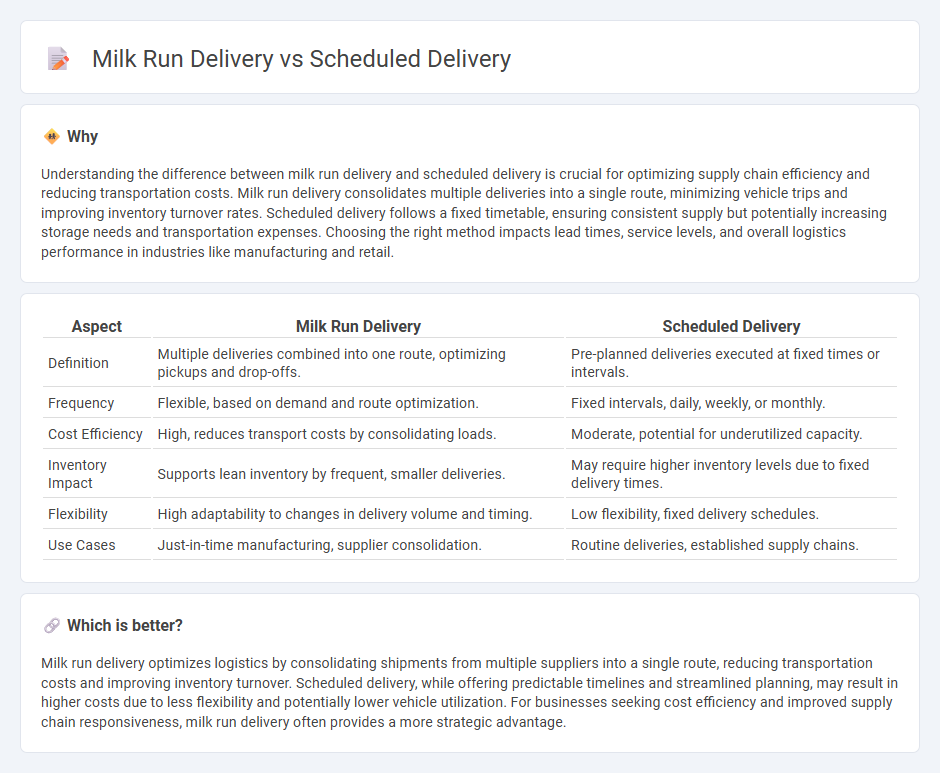
Milk run delivery streamlines supply chain efficiency by consolidating multiple deliveries into a single trip, reducing transportation costs and minimizing inventory levels. Scheduled delivery adheres to fixed time windows, ensuring predictable and timely shipments that support production planning and customer satisfaction. Explore the key differences and benefits of milk run versus scheduled delivery to optimize your logistics operations.
Why it is important
Understanding the difference between milk run delivery and scheduled delivery is crucial for optimizing supply chain efficiency and reducing transportation costs. Milk run delivery consolidates multiple deliveries into a single route, minimizing vehicle trips and improving inventory turnover rates. Scheduled delivery follows a fixed timetable, ensuring consistent supply but potentially increasing storage needs and transportation expenses. Choosing the right method impacts lead times, service levels, and overall logistics performance in industries like manufacturing and retail.
Comparison Table
| Aspect | Milk Run Delivery | Scheduled Delivery |
|---|---|---|
| Definition | Multiple deliveries combined into one route, optimizing pickups and drop-offs. | Pre-planned deliveries executed at fixed times or intervals. |
| Frequency | Flexible, based on demand and route optimization. | Fixed intervals, daily, weekly, or monthly. |
| Cost Efficiency | High, reduces transport costs by consolidating loads. | Moderate, potential for underutilized capacity. |
| Inventory Impact | Supports lean inventory by frequent, smaller deliveries. | May require higher inventory levels due to fixed delivery times. |
| Flexibility | High adaptability to changes in delivery volume and timing. | Low flexibility, fixed delivery schedules. |
| Use Cases | Just-in-time manufacturing, supplier consolidation. | Routine deliveries, established supply chains. |
Which is better?
Milk run delivery optimizes logistics by consolidating shipments from multiple suppliers into a single route, reducing transportation costs and improving inventory turnover. Scheduled delivery, while offering predictable timelines and streamlined planning, may result in higher costs due to less flexibility and potentially lower vehicle utilization. For businesses seeking cost efficiency and improved supply chain responsiveness, milk run delivery often provides a more strategic advantage.
Connection
Milk run delivery optimizes supply chain efficiency by consolidating multiple pickups and deliveries into a single route, reducing transportation costs and improving inventory management. Scheduled delivery ensures timely and consistent shipment arrivals aligned with production schedules or customer demands, enhancing supply chain reliability. Integrating milk run delivery with scheduled delivery leverages route efficiency and timing precision to minimize lead times and optimize resource utilization.
Key Terms
Fixed Route
Scheduled delivery follows a predetermined timetable, ensuring consistent arrival times along a fixed route that optimizes efficiency and reduces wait times. Milk run delivery consolidates multiple pickups or drop-offs along a fixed route, minimizing transportation costs and improving supply chain integration. Explore the benefits and applications of fixed route strategies in logistics for enhanced operational performance.
Time Window
Scheduled delivery ensures precise adherence to predetermined time windows, optimizing supply chain predictability and reducing waiting times at receiving docks. Milk run delivery integrates multiple pick-ups or drop-offs within a consolidated route, benefiting from flexible yet efficient time windows that balance route optimization and delivery punctuality. Explore how aligning delivery methods with time window strategies can enhance operational efficiency and customer satisfaction.
Consolidated Shipment
Scheduled delivery involves predetermined shipping times where goods are transported individually as per fixed calendars, whereas milk run delivery consolidates multiple shipments from various suppliers into a single trip, reducing transportation costs and improving efficiency. Consolidated shipment in milk run delivery leverages economies of scale to optimize freight handling and minimize vehicle idle time, enhancing supply chain responsiveness. Explore detailed strategies on how consolidated shipments can transform your logistics operations.
Source and External Links
What is Scheduled Delivery? Why is it Important? - Scheduled delivery is a service where customers select a specific, prearranged date and time slot for receiving a shipment, allowing convenience, flexibility, and enhanced security by ensuring someone is available to receive the package.
What is Scheduled Delivery, and How Does it Work? - Scheduled delivery allows customers to choose exact delivery dates and times, offering a precise and customizable delivery experience that improves customer satisfaction and operational efficiency in logistics.
On-Demand vs. Scheduled Deliveries: What's the Difference? - Scheduled delivery services provide planned delivery slots with predictable arrival times, helping customers plan better, reduce missed deliveries, and often lower costs compared to urgent or on-demand deliveries.
 dowidth.com
dowidth.com